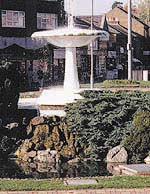CHESHUNT CHESHUNT is situated just three minutes' drive from the M25
motorway and close to the A10 Great Cambridge Road. It is served by a comprehensive public
transport system including a British Rail station with trains operating to and from
Liverpool Street, London and Cambridge. Cheshunt also has a full local bus service. |
|
At the heart of Cheshunt is the Old Pond and Fountain, a
prominent local feature surrounded by parades of shops providing a range of convenient
goods and services. These include children/ladies fashions, travel agents, supermarket, a
post office, a library and a Broxbourne Council One Stop Shop. Within walking distance of
the Old Pond are two main car parks including spaces for disabled persons, as well as
convenient on street parking for short visits.
Cheshunt is home to the Grundy Park Leisure Centre, which boasts superb sporting and
leisure facilities for the whole family, including a swimming pool, fitness suite, sports
hall, squash courts and a health and beauty centre. Situated close to the Old Pond are
shopping area of Turners Hill and the High Street, Cheshunt, which offer excellent
specialist shopping facilities and on street parking facilities. The Cheshunt shopping
centre hosts a number of family fun shopping events and various street entertainments
throughout the year.
Cheshunt also contains the borough offices. The grounds and buildings of the offices
centre around the former Churchgate House, an 18th century building close to the parish
church in the oldest corner of Cheshunt.
In 1969 the previous theological college closed and the buildings, having been extensively
refurbished, now stand alongside new buildings, erected in the grounds to centralise all
borough council functions.
Also of interest in this older part of Cheshunt are the buildings of Dewhurst Charity
school of 1640, the upper floor of which has been converted for residential use. The
nearby houses in Churchgate, together with Whit Hern Park, form part of a conservation
area.
The Churchgate conservation area lies half a mile from Cheshunt Old Pond at the western
end of College Road. The area is steeped in history and contains several distinguished old
buildings and a beautifully landscaped park.
Designated a conservation area in 1968, Churchgate was one of the very first historic
centres in Britain to receive this status. Twenty-three buildings in the area are listed
for their special architectural and historic value.
Cheshunt was mentioned in the Domesday Book of 1086 when it was known as Chestrehunt. The
name 'Chestre' or 'Chester' is usually indicative of the presence of a Roman fortification
whilst 'hunt' derives from a saxon word meaning wooded.
From the Domesday survey it is evident that Chestrehunt was a small manorial settlement on
the site of modern Churchgate in a well-wooded area. The name Churchgate is almost
certainly a reference to a prominent set of gates that once stood at the south east corner
of St Mary's churchyard.
St Mary's Church provides an attractive focus to the conservation area. Built in 1418, it
occupies the site of an earlier church. It was extended in 1872-3 (South Chapel) and
1883-4 (South Porch). It is a Grade One listed building of which there are only five in
the borough and is therefore very important in an architectural and historic context
locally.
In recent years the church has undergone considerable repair, grant aided by both the
council and English Heritage.
The parish church of St Mary the Virgin located in the Churchgate conservation area lies
half a mile from Cheshunt old Pond at the western side of College Road.
The best-known monument in Cheshunt is Temple Bar, which can be found just south of the
Lieutenant Ellis Way (formerly known as the Flamstead End relief road).
The Bar was first erected in its present form in 1672 to replace the wooden bar that was
destroyed by the Great Fire of London. It was designed by Sir Christopher Wren and stood
as a gateway to Fleet Street at its junction with The Strand.
The bar was used to display heads of traitors on iron spikes that protruded from the top
of the main arch. The last heads displayed were those of Townley and Fletcher, who were
taken at the Siege of Carlisle and executed in 1746.
The Court of the Common Council finally decided to move the bar so as to widen Fleet
Street to accommodate increasing traffic. The bar was dismantled and transported to a
vacant lot in Farringdon Street.
It was not until Valerie Lambton, a barmaid at the Horseshoe Tavern on Tottenham Court
Road, married the brewer Sir Henry Meux, the owner of Theobalds Park, that the bar was
reassembled. She paid for the transportation of the bar to Theobalds Park where it was
resurrected close to her manor at a cost of �12,000.
While Temple Bar was in the ownership of Lady Meux she regularly entertained guests in its
upper chamber; King Edward VII, The Prince of Wales and Winston Churchill are believed to
have dined there.
The site of Theobalds Palace lies to the east of the A10 and to the south of Theobalds
Lane.
James I died at Theobalds in 1625 and was succeeded by Charles I who spent much of his
childhood there. Although he hardly ever returned in later life, it was from Theobalds
that he rode forth to Nottingham to raise his standard in the Civil War. During the war
the palace was much plundered and defaced.
